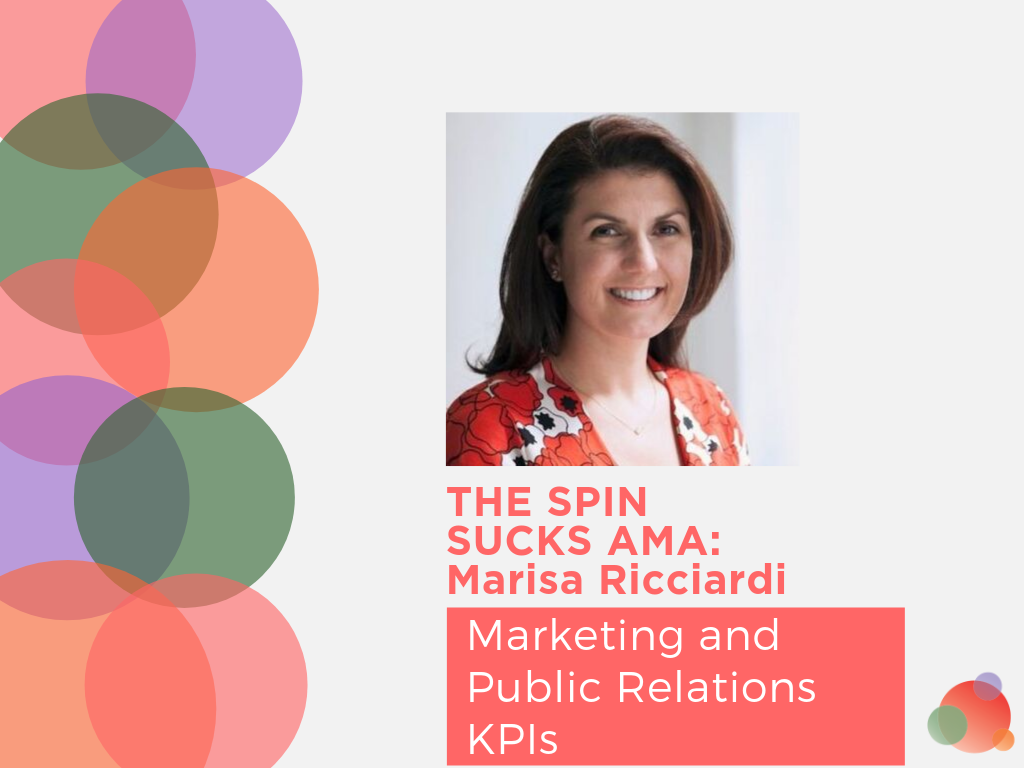 Public relations doesn’t have the best history when it comes to measurement and KPIs.
Public relations doesn’t have the best history when it comes to measurement and KPIs.
Marketing might have a bit of a leg up, but not much.
As organizations demand key performance indicators tied to business goals such as leads and sales, marketing and PR will need to adapt.
But which marketing or public relations KPIs would you use to measure your success and why?
And how do you design measurement so it captures the right metrics to demonstrate the value of your communications programs?
For October’s #SpinSucksAMA, Martin Waxman sat down with Marisa Ricciardi, founder and CEO of The Ricciardi Group, and a wealth of knowledge when it comes to marketing measurement.
For this session, we focused on which types of marketing and communications programs work best when your KPIs are leads and sales.
Which Public Relations KPIs Should we Track?
Marisa got right to the point:
“We look at three things with every client and one is directly aligned with sales revenue. So even though we may not work directly with the CEO, we’re usually working with the CIO. We say the best marketing plans come out of a business plan.
If there’s a strong business goal, or there’s a strong sales target, that is also our marketing objective.
We’re trying to be as close to customer revenue as possible.
We were working with a startup recently and they wanted to get to a $60 million top line revenue growth by the end of the year. That was their very specific number. So that became our top line KPI.
Now we’re not directly attributing what we do to every dollar, of course, and every sales effort, but if we adjust the way we’re talking, our efforts align with how close we were getting to that goal.
It just makes our value feel a lot more integrated with the economic True North of our client.”
What are the other elements?
Marisa:
“The second thing we look at is MQL.
MQL is a marketing qualified lead versus an SQL, which is a sales qualified lead.
We look at the number of leads we’ve either put into the pipeline, or leads we’ve gotten from demos on a website, or webinars such as this.
We’re very clear to differentiate what the difference is between something that we view as qualified as marketers versus how sales view it.
Finally, when we’re doing paid advertising, we look at cost per lead or cost per conversion.
A lot of times that’s usually easier when you’re doing paid dollars and you can look at the conversion rate.
So if we spent $10 trying to acquire an individual on LinkedIn, for example, what does it cost to then take that person through the life cycle and actually convert them to being a client?
When you can get really tight on those numbers, it makes the conversation much easier because you can show the cost per conversion versus an average contract value.
At the Ricciardi Group, we do mostly B2B clients so we’re not a consumer brand agency.
We spend most of our time working with enterprise clients and folks that sell software or technology.
We have some professional services, but when it’s a technology product, it’s much easier to show to show a conversion rate than whether or not they’ve signed up for that particular product.”
Breaking Down the Agency Side of Things
Chip Griffin, host of Agency Leadership podcast, attended the AMA and asked:
“Since you’re from the client-side, are there things that surprised you about moving to the agency business, or things you wish you had known before you launched the Ricciardi Group?”
Marisa’s answer was refreshingly honest:
“The things I didn’t know were just how hard it really is, especially as a startup.
I’ve come from big public companies with 10,000 plus employees. When you’re starting with 10 employees or zero to 10—and now almost 20—you realize how much you have to cobble together.
I always thought that an agency had an off the shelf product and just served you up.
Here’s our RFP response or here’s our content strategy plan. Some things are getting more templated as we mature, but the customization involved in making it relevant is so time consuming.
I think it’s important because that’s ultimately how you win businesses. You don’t want the client to feel like you’re just giving them something generic.”
Our Next #SpinSucksAMA
If you’d like to participate in our next #SpinSucksAMA, all you need to do is join our community.
If you’re already part of our community, our next #SpinSucksAMA is happening on November 11th, at 1PM ET. Stay tuned for more details as we get closer to the date.
If you missed our last #SpinSucksAMA, here’s a brief recap with Marisa.
We hope you tuned in and we hope to see you next time!